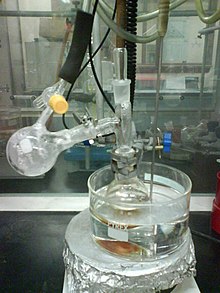
Back تقطير تفريغي Arabic Destil·lació al buit Catalan Destilace za sníženého tlaku Czech Vakuumdestillation German Destilación al vacío Spanish Vaakumdestillatsioon Estonian تقطیر خلأ Persian Tyhjötislaus Finnish निर्वात आसवन Hindi Distillazione sottovuoto Italian

Vacuum distillation or distillation under reduced pressure is a type of distillation performed under reduced pressure, which allows the purification of compounds not readily distilled at ambient pressures or simply to save time or energy. This technique separates compounds based on differences in their boiling points. This technique is used when the boiling point of the desired compound is difficult to achieve or will cause the compound to decompose.[1] Reduced pressures decrease the boiling point of compounds. The reduction in boiling point can be calculated using a temperature-pressure nomograph using the Clausius–Clapeyron relation.[2]
- ^ Hickman, K. C. D. (1945), "Adventures in vacuum chemistry", American Scientist, 33 (4), Scientific american: xxx–231, JSTOR 27826079, retrieved 2021-09-01
- ^ "Pressure-Temperature Nomograph Interactive Tool". Sigma-Aldrich. Retrieved 2018-03-23.
© MMXXIII Rich X Search. We shall prevail. All rights reserved. Rich X Search